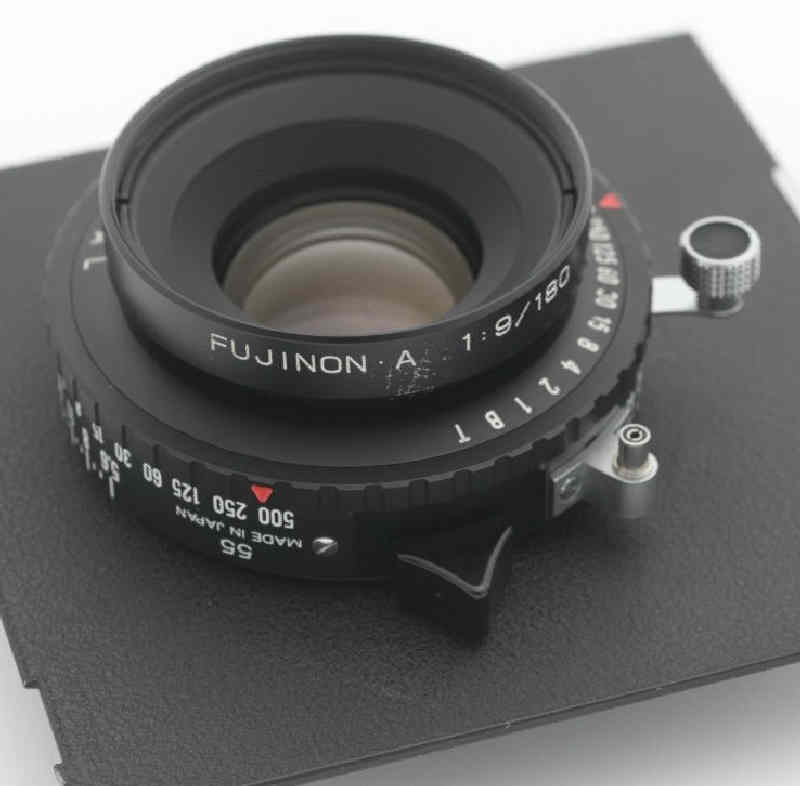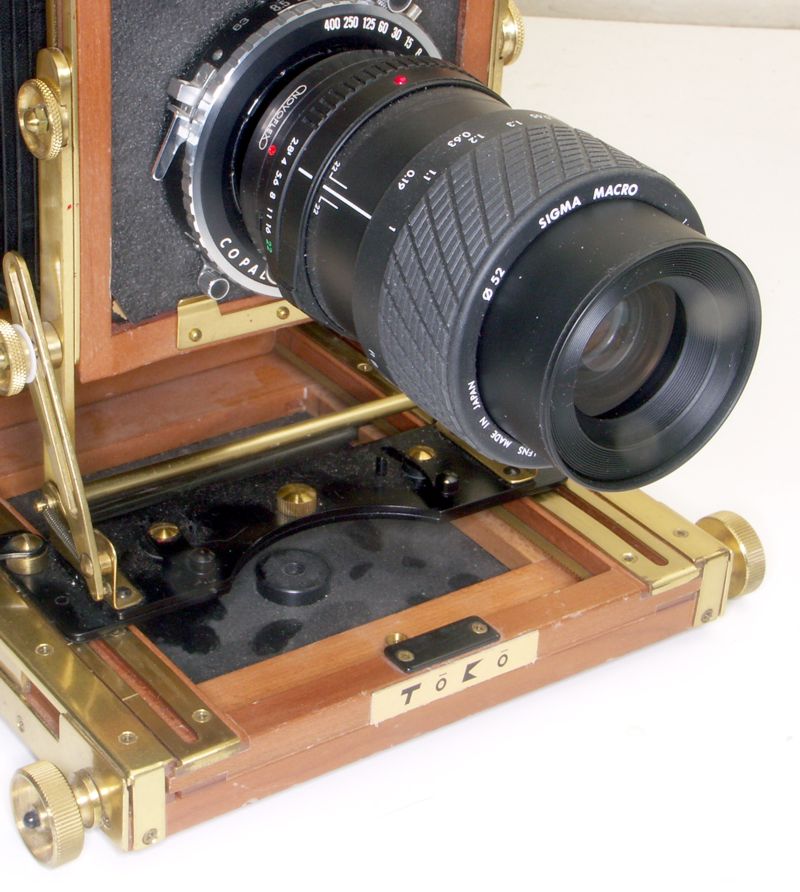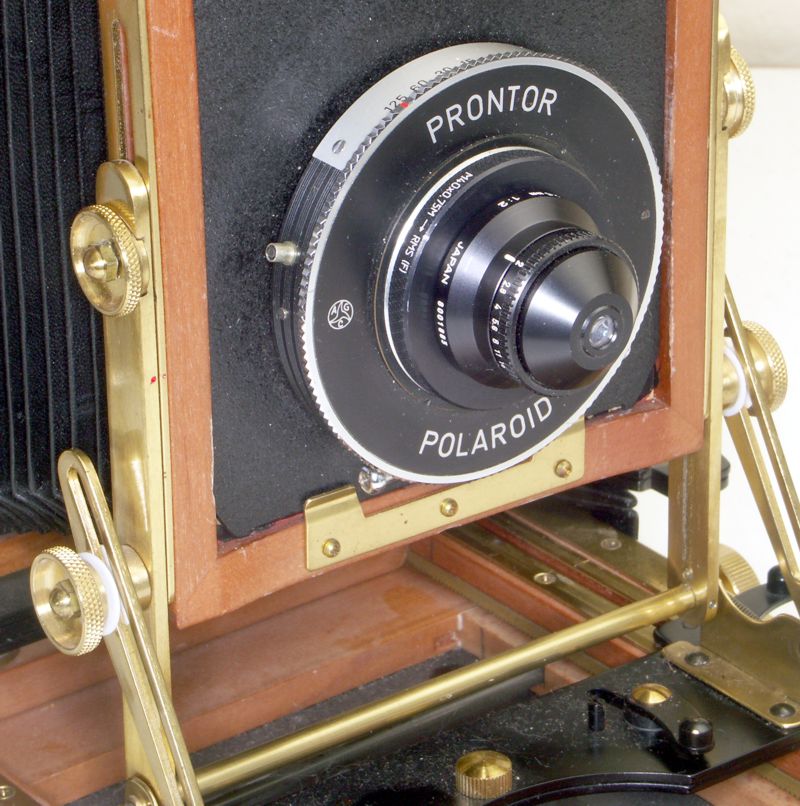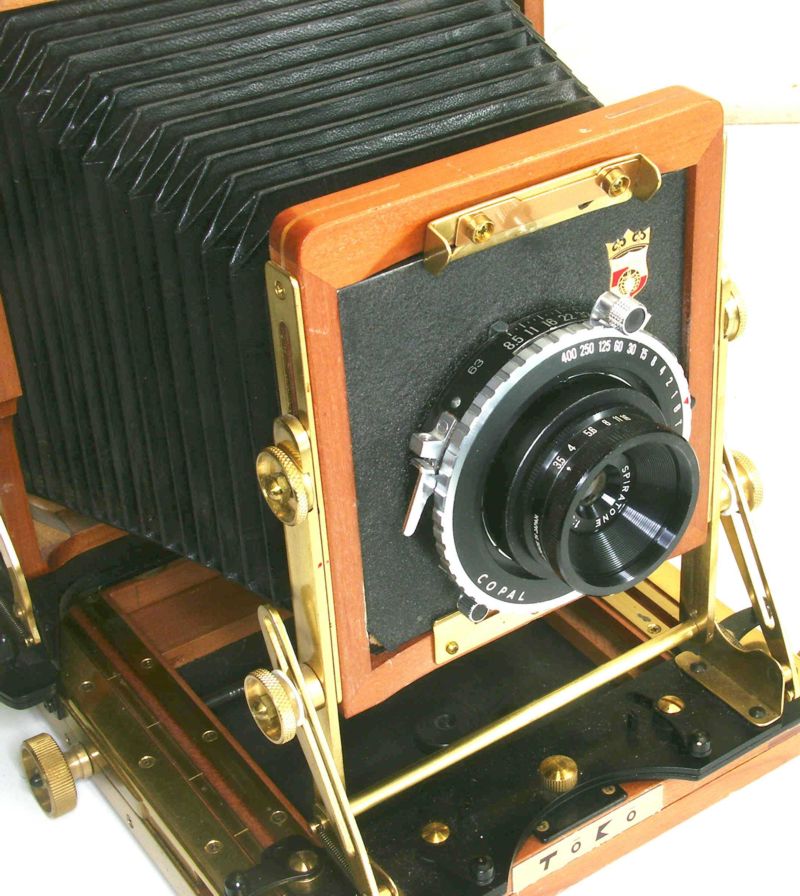
Using
or Making your Own
Large Format Macro lenses
There are several ways and several reasons why close-up photography is different with large format cameras -- as opposed to smaller formats.
With the 35mm format, for example, there are lots are lenses made with close-up capability built-in, and plenty of macro lenses, and well as extension tubes & bellows to create extension. While these options make macro photography very easy for smaller formats, it is quite different with large format gear. Unfortunately because large format cameras have an adjustable bellows, many users assume that close-up work is simple because all you need to do is extend the bellows to make macro photographs. While this is true to a certain extent, it does not mean that your results will be any good.
The biggest issue is that most lenses are not designed for optimum results at the high magnifications that constitute close-up work. While they may give great results when taking pictures of subjects at a distance, the closer you get, the worse the results will be -- lower resolution and clarity. That's where special lenses designed for close-up work are the best approach -- especially if you do a lot of close-up work. These special lenses were made by a lot of different lens makers, but not all of them were designed with large format cameras in mind. They have a variety of different names, such as "process lens", "copy lens", reproduction lens", and sometimes "macro lens". The important thing is not what it is called or labeled, but to look at the manufacturer's literature to see what magnification the lens is designed for. A typical example might be "designed for 1:5 to 5:1 reproduction -- meaning this lens is designed for photos at 1/5th life size to 5 times life size. In the 4x5" format, that would mean a subject that is about one inch to 2 feet in size.
There are many other lenses that can be used for large format macro work that you might not think about, such as microscope lenses. These are designed for very high magnification, and are easily adapted to large format cameras. Similarly, macro lenses designed for smaller format cameras can also be similarly adapted. All it takes is a little ingenuity -- and forethought -- and maybe an adapter. This same creativity can have you turning your enlarging lens(es) into a large format macro lens(es).
In other words, you might already have everything you need to make great, large format, macro photos. Let's take a closer look by the type of lenses that you might already have -- or might be able to get pretty easily.
The first thing is to try to figure out if you need in a macro lens. One place to start is to estimate how much magnification you will need. If your smallest object will be about 4", then a lens that can handle 1X will do, but if you want much higher magnification, such as 20X, you will want a different lens. Much depends on your camera and how much bellows extension you have.
Start by computing the maximum magnification you have with your current gear -- using this formula. Take your maximum bellows extension, and divide it by the focal length of the lens(es) that you have. For example, 300mm / 150mm = 2. Then subtract 1. You get 1X maximum magnification with a 150mm lens and 300mm of extension. If you want greater magnification, you have two options -- increase the amount of bellows, if you can, or use a shorter focal length lens. Use the same formula to estimate how much extension you will need, or how short a lens you will have to get. For example, 300mm / 50mm = 6. Subtract 1 and you have 5X magnification.
(FYI, You can also use this magnification formula to determine how much the exposure needs to be corrected due to the amount of extension involved. There are different formulas -- which I won't regurgitate here -- that you can use depending on if you want to correct the exposure through a change in the film speed, the amount of illumination, a change in the f-stop, or a shutter speed adjustment. But the first thing you need to know is the magnification.)
Another important consideration related to magnification is diffraction -- a reduction in image clarity with very small apertures. As the magnification increases, the depth-of-field decreases dramatically. This can be overcome by stopping down the lens, but as the aperture becomes smaller there is an increase in diffraction -- and lack of clarity is the last thing you want in a highly magnified subject. It becomes a tug-of-war between DOF and image clarity. Consider a photo of a subjext at f16. Under normal conditions, the diffraction would be minimal, but at 4X magnification, the effective aperture is f80 -- which will result in a severe deterioration of clarity. The best approach is to open-up the aperture (and using a faster shutter speed) even though the DOF will be reduced. Fortunately with a large format camera, movements can be made to adjust the plane of focus and apparent DOF. But how much should the aperture be adjusted to minimize diffraction? It depends in part on the magnification, the desired DOF, and the subject. Here is a table with some sample lenses of various focal lengths, magnifications, and suggested f-stops.

As you can see, with lower magnifications, smaller apertures can be used with minimal diffraction, but as the magnification increases, it's important to open the lens up -- quite a bit. And like in many photographic situations, one approach is to take several pictures at different settings -- Bracket to beat Diffraction.
Large Format Lenses -- You can use any large format lens for close-up work -- just add more bellows extension! The results just won't be as good as they could be, because most large format lenses were not made with close-up magnifications in mind. But every large format lens manufacturer made lenses that were designed for close-up work. Look at the manufacturer's literature, and if the lens was designed for macro work, it will indicate the magnifications that the lens is designed for, such as "designed for 1:5 to 5:1 reproduction. These lenses may also be given a particular designation by the maker, such as Fuji's "A" series , Schneider's Artar & Claron series, Rodenstock's Ronar series, or Nikon's "M" series. Most of these are lenses over 100mm in focal length, which can be a problem if you have a short bellows. For example, with the Fujinon A 180mm, you need to have 360mm of bellows to reach 1:1 (1X, life-size) magnification. For high magnification work, you might need to go for shorter lenses -- but that also means the lens will be much closer to the subject.

Smaller format lenses -- There are a ton of macro lenses made for smaller formats from Nikon, Tokina, Minolta, Vivitar, Olympus, Tamron, Canon, Sigma, Yashica, Fuji, Contax, Mamiya, Pentax,......... I could go on all day. These great macro lenses are easily adapted for large format camera use -- and will fill the frame of larger formats when given enough bellows extension & magnification. Most of these lenses are in the 50mm to 200mm range, but many were much shorter -- like 12.5mm -- or much longer -- like 300mm. All you need is an adapter or two to attach the lens to your shutter -- for example, a Minolta-to-Leica adapter, and a Leica-to-Copal adapter. Here is a Sigma 50mm f2.8 macro lens with such a setup -- for up to 8X magnification.

Microscope lenses -- Microscope lenses are really just lenses for even tinier formats, but they can still be used on large format cameras. These lenses are normally referred to as "objectives", not "lenses", and they are typically listed in "magnifications", not "focal lengths" -- such as 10X, 30X, or 100X. Similarly, their apertures are not listed in f-stops, but as a numerical apertures -- such as .10, .30, .80. This is done because most are used at their fixed aperture, and lack an adjustable diaphragm -- but it's easy to translate these details into focal lengths and f-stops. Microscope lenses usually have a Royal Microscope Society (RMS) rear thread, but it's easy to find or make an RMS-to-Copal adapter -- and with enough extension, the microscope "objective" will fill the large format film. Here is a Minolta 12.5mm microscope lens on a 4x5 camera using an RMS-to-#1 Shutter adapter -- for up to 30X magnification.

Enlarging lenses -- a popular way to get into macro work is to use enlarging lenses. While not designed for close-up magnification, it's easy to adapt enlarger lenses to large format shutters. Typically, enlarging lenses give much better close-up performance if reversed. The list of enlarging lenses is almost endless, and here is a website that covers just about all of them with details -- PHOTO CORNUCOPIA. As with smaller format macro lenses and microscope lenses, you'll need an easy-to-get adapter, or two, to attach the enlarging lens to your camera. Here is an un-reversed, Spiratone 35mm f3.5 enlarging lens on a 4x5 camera using a Leica-to-Copal adapter:

As you can see, there are endless ways to get into macro-photography with large format cameras -- without spending a lot of money.